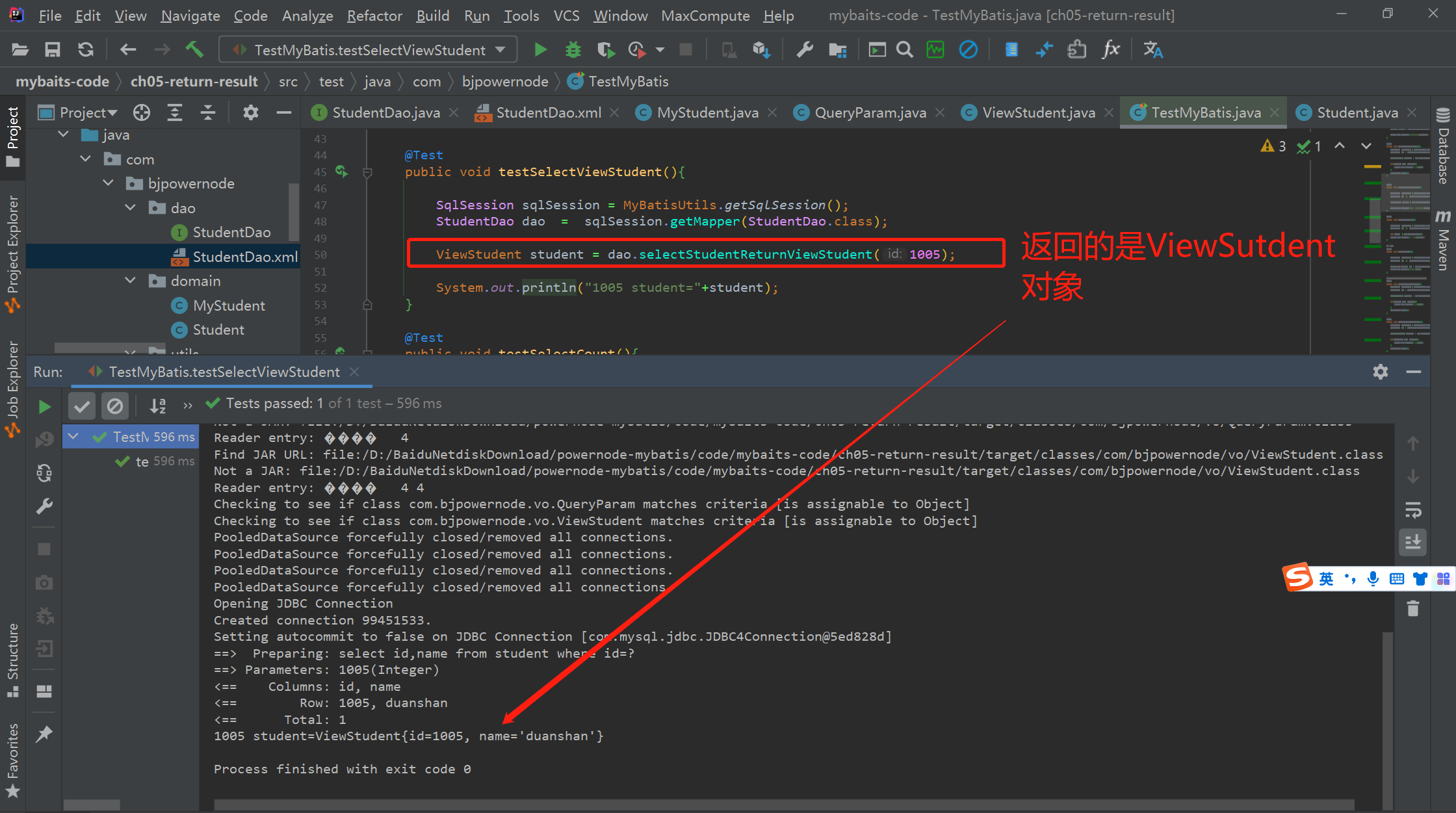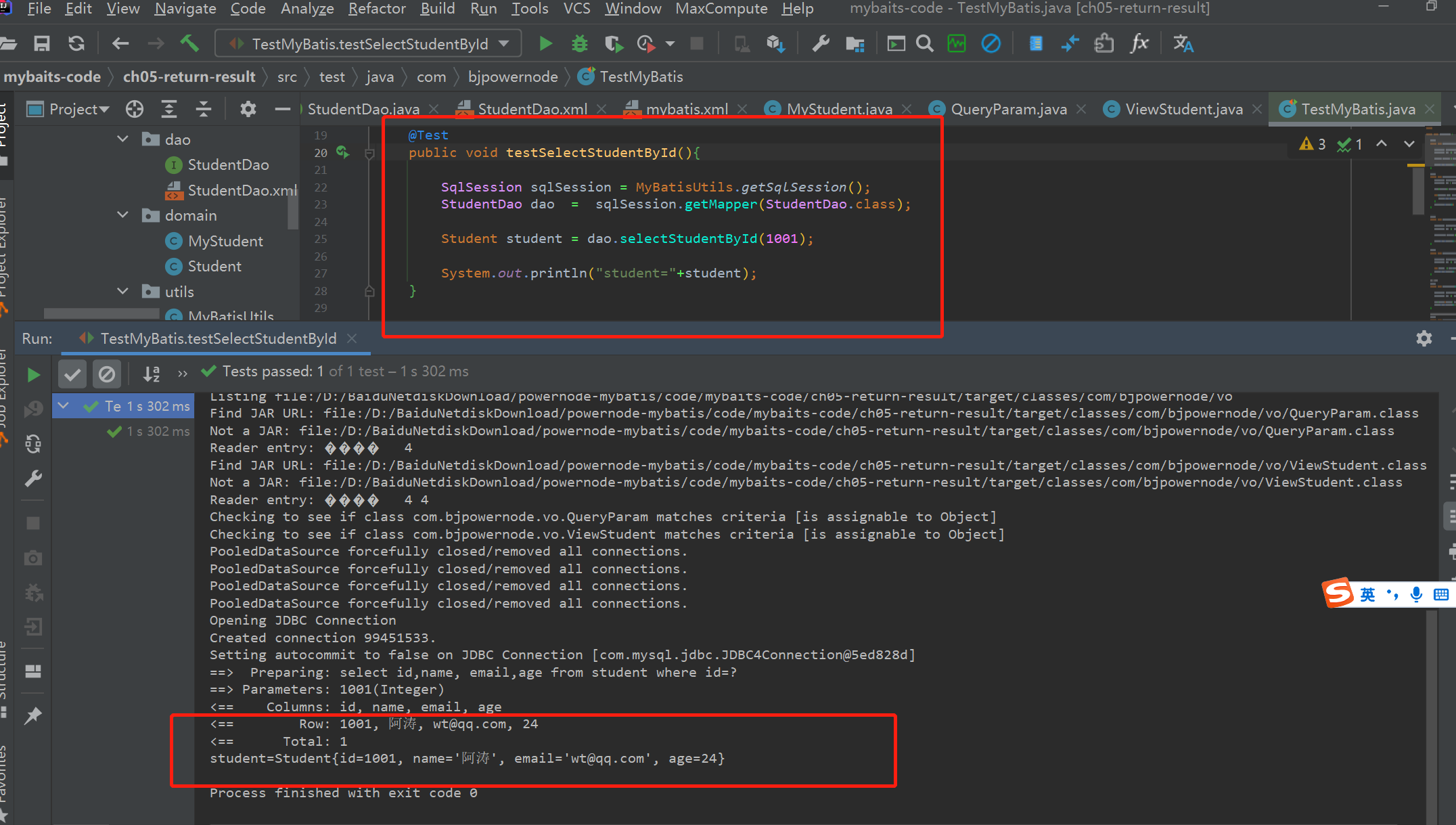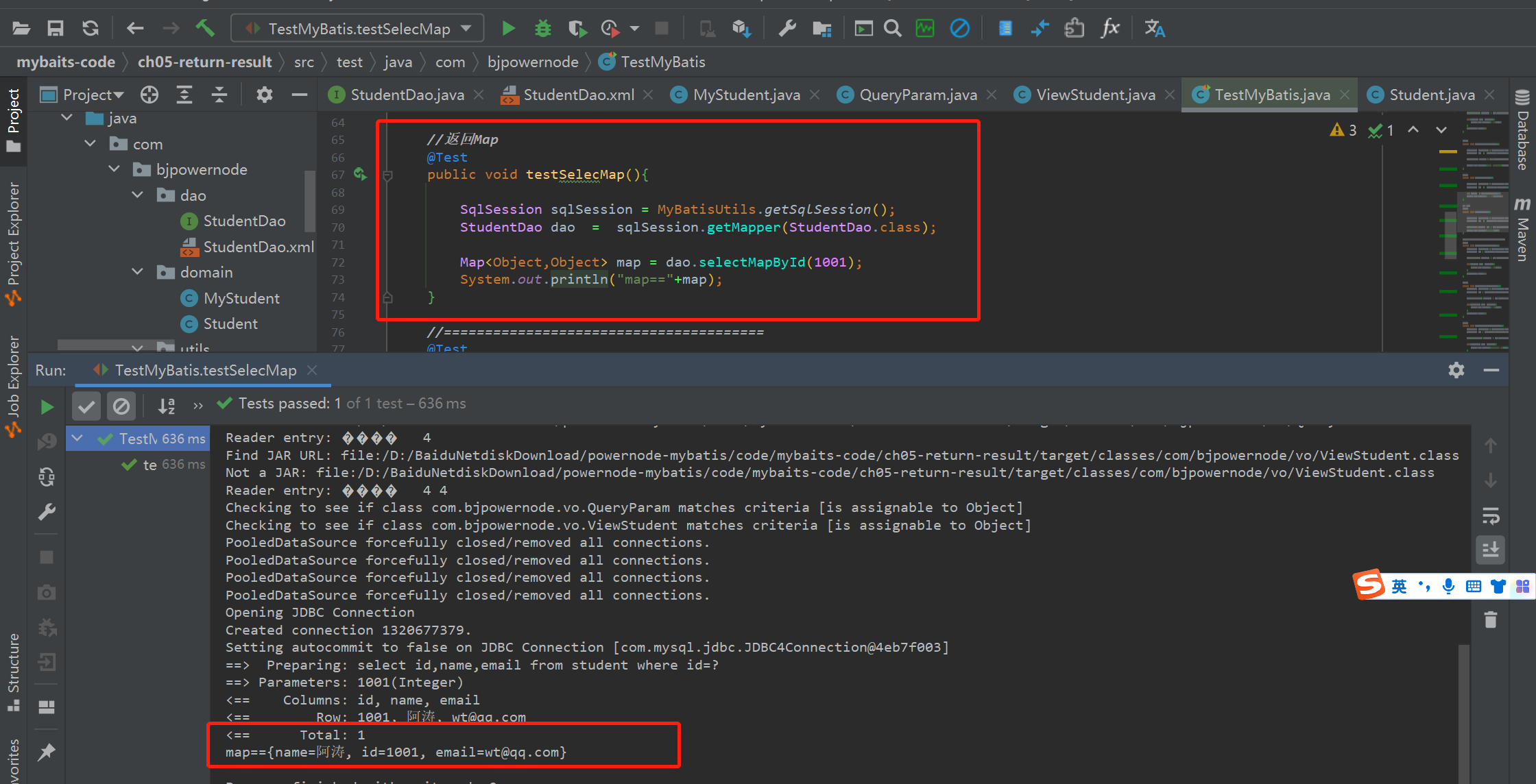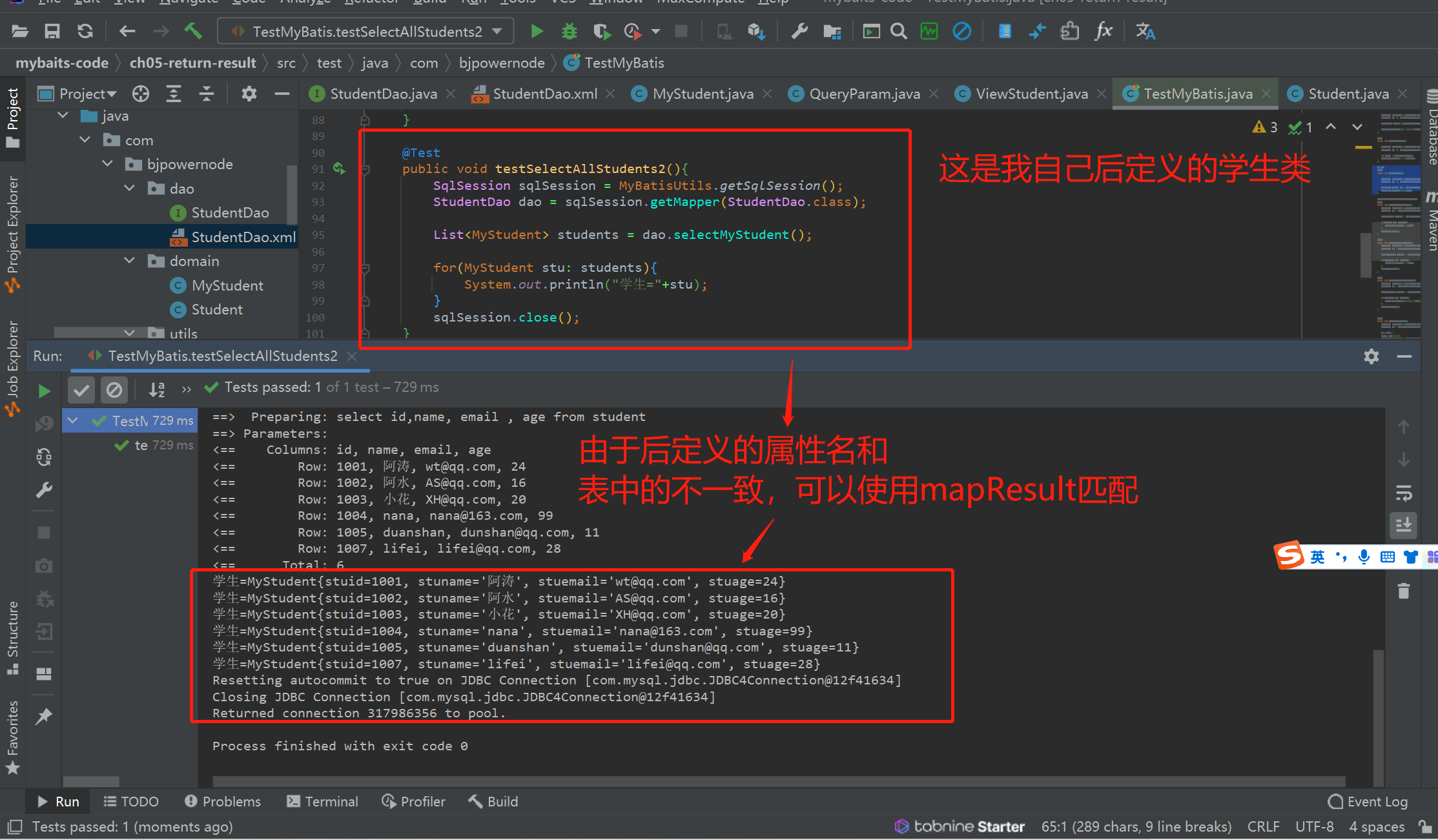封装 MyBatis 输出结果
resultType: 执行 sql 得到 ResultSet 转换的类型,使用类型的完全限定名或别名。 注意如果返回的是集合,那应该设置为集合包含的类型,而不是集合本身。resultType 和 resultMap,不能同时使用。
1.对象类型
在实体类中不仅表对应的实体类可以拿到数据库中的值,只要字段名字对应还可以赋值给其他类、
-
定义一个类
package com.bjpowernode.vo; public class ViewStudent { private Integer id; private String name; public Integer getId() { return id; } public void setId(Integer id) { this.id = id; } public String getName() { return name; } public void setName(String name) { this.name = name; } @Override public String toString() { return "ViewStudent{" + "id=" + id + ", name='" + name + '\'' + '}'; } } -
配置mappery映射,将数据库中的数据赋值给这个viewstudent
<!--selectStudentReturnViewStudent--> <select id="selectStudentReturnViewStudent" resultType="ViewStudent"> select id,name from student where id=#{sid} </select> -
测试如下:
在接口的对应配置文件中:
<select id="selectStudentById" resultType="Student">
select id,name, email,age from student where id=#{studentId}
</select>执行结果如下:
2. 简单类型
接口方法:
int countStudent();
mapper 文件:
<select id="countStudent" resultType="int">
select count(*) from student
</select>
测试方法:
@Test
public void testRetunInt(){
int count = studentDao.countStudent();
System.out.println("学生总人数:"+ count);
}结果如下:
3. map
sql 的查询结果作为 Map 的 key 和 value。推荐使用 Map<Object,Object>。注意:Map 作为接口返回值,sql 语句的查询结果最多只能有一条记录。大于一条记录是错误。
接口方法:
//定义方法返回Map
Map<Object,Object> selectMapById(Integer id);mapper 映射文件
只能最多返回一行记录。多余一行是错误
<!--返回Map
1)列名是map的key, 列值是map的value
2)只能最多返回一行记录。多余一行是错误
-->
<select id="selectMapById" resultType="java.util.HashMap">
select id,name,email from student where id=#{stuid}
</select>测试方法如下:
//返回Map
@Test
public void testSelecMap(){
SqlSession sqlSession = MyBatisUtils.getSqlSession();
StudentDao dao = sqlSession.getMapper(StudentDao.class);
Map<Object,Object> map = dao.selectMapById(1001);
System.out.println("map=="+map);
}结果如下;
4. resultMap
resultMap 可以自定义 sql 的结果和 java 对象属性的映射关系。更灵活的把列值赋值给指定属性。常用在列名和 java 对象属性名不一样的情况。
其实就是手动的让数据库中的列值赋值到实体类中的各个属性上,具体实现如下:
<!--使用resultMap
1)先定义resultMap
2)在select标签,使用resultMap来引用1定义的。
-->
<!--定义resultMap
id:自定义名称,表示你定义的这个resultMap
type:java类型的全限定名称
-->
<resultMap id="studentMap" type="com.bjpowernode.domain.Student">
<!--列名和java属性的关系-->
<!--注解列,使用id标签
column :列名
property:java类型的属性名
-->
<id column="id" property="id" />
<!--非主键列,使用result-->
<result column="name" property="name" />
<result column="email" property="email" />
<result column="age" property="age" />
</resultMap>
<select id="selectAllStudents" resultMap="studentMap">
select id,name, email , age from student
</select>5. 实体类属性名和列名不同的处理方式可能会用到
-
方法一:使用resultMap
-
创建实体类
package com.bjpowernode.domain; public class MyStudent { private Integer stuid; private String stuname; private String stuemail; private Integer stuage; public Integer getStuid() { return stuid; } public void setStuid(Integer stuid) { this.stuid = stuid; } public String getStuname() { return stuname; } public void setStuname(String stuname) { this.stuname = stuname; } public String getStuemail() { return stuemail; } public void setStuemail(String stuemail) { this.stuemail = stuemail; } public Integer getStuage() { return stuage; } public void setStuage(Integer stuage) { this.stuage = stuage; } @Override public String toString() { return "MyStudent{" + "stuid=" + stuid + ", stuname='" + stuname + '\'' + ", stuemail='" + stuemail + '\'' + ", stuage=" + stuage + '}'; } } -
配置mapper文件
<resultMap id="myStudentMap" type="com.bjpowernode.domain.MyStudent"> <!--列名和java属性的关系--> <id column="id" property="stuid" /> <!--非主键列,使用result--> <result column="name" property="stuname" /> <result column="email" property="stuemail" /> <result column="age" property="stuage" /> </resultMap> <!--列名和属性名不一样:第一种方式--> <select id="selectMyStudent" resultMap="myStudentMap"> select id,name, email , age from student </select> -
测试如下:
-
-
方式二:直接在sql中该表列名字(更简单写)
<!--列名和属性名不一样:第二种方式 resultType的默认原则是 同名的列值赋值给同名的属性, 使用列别名(java对象的属性名) --> <select id="selectDiffColProperty" resultType="com.bjpowernode.domain.MyStudent"> select id as stuid ,name as stuname, email as stuemail , age stuage from student </select>6. 模糊 like
模糊查询的实现有两种方式, 一是 java 代码中给查询数据加上“%” ; 二是在 mapper 文件 sql 语句的条件位置加上“%”
需求:查询姓名有“力”的
例 1: java 代码中提供要查询的 “%力%”
接口方法:
List<Student> selectLikeFirst(String name);
mapper 文件:
<select id="selectLikeFirst" resultType="com.bjpowernode.domain.Student">
select id,name,email,age from student
where name like #{studentName}
</select>
测试方法:
@Test
public void testSelectLikeOne(){
String name="%力%";
List<Student> stuList = studentDao.selectLikeFirst(name);
stuList.forEach( stu -> System.out.println(stu));
}
例 2:mapper 文件中使用 like name "%" #{xxx} "%"
接口方法:
List<Student> selectLikeSecond(String name);
mapper 文件:
<select id="selectLikeSecond" resultType="com.bjpowernode.domain.Student">
select id,name,email,age from student
where name like "%" #{studentName} "%"
</select>
测试方法:
@Test
public void testSelectLikeSecond(){
String name="力";
List<Student> stuList = studentDao.selectLikeSecond(name);
stuList.forEach( stu -> System.out.println(stu));
}<!--第一种 like , java代码指定 like的内容-->
<select id="selectLikeOne" resultType="com.bjpowernode.domain.Student">
select id,name,email,age from student where name like #{name}
</select>
<!--第二种方式:在mapper文件中拼接 like的内容-->
<select id="selectLikeTwo" resultType="com.bjpowernode.domain.Student">
select id,name,email,age from student where name like "%" #{name} "%"
</select>



